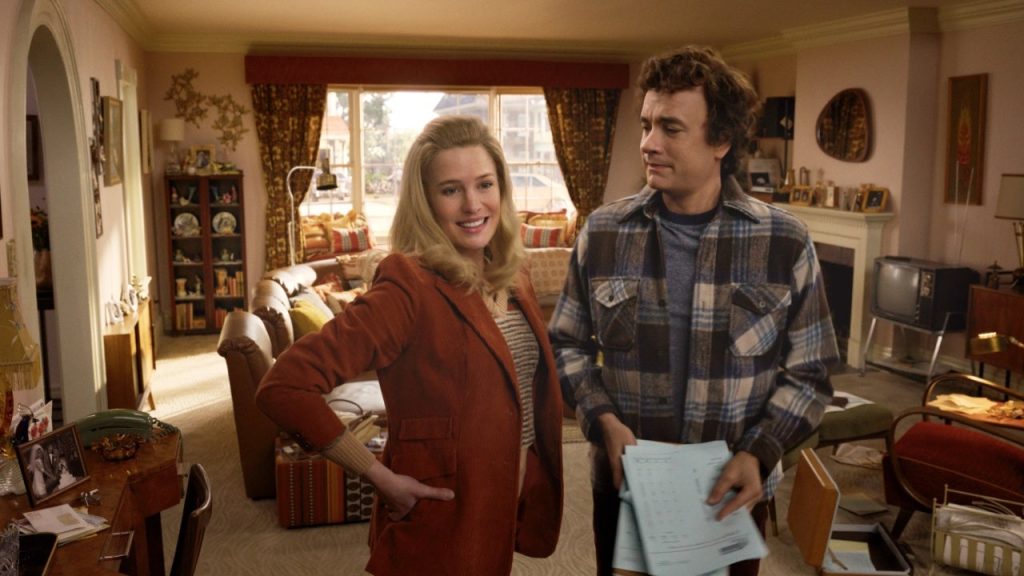"Here": A Deep Dive into Robert Zemeckis’ Latest Cinematic Venture
Robert Zemeckis’ film "Here," based on the groundbreaking graphic novel by Richard McGuire, opened in theaters on November 1, offering audiences a unique cinematic experience. The film explores the life of the Youngs, an American family, and traces their lineage through various significant and everyday moments of the 20th century, all within the confines of their living room. However, despite its ambitious premise and notable cast, "Here" has its share of challenges, ranging from its singular perspective to the technological execution that seems to detract from its storytelling.
Singular Setting, Multiple Eras
The Central Gimmick
"Here" stands out due to its unusual narrative technique; it situates the camera in a constant position in the corner of a living room, allowing the story to unfold from this unique vantage point. As the film transitions through decades, utilizing ingenious frames-within-frames, it captures the evolution of the American family and their interactions with their home space. This methodology, though inventive, has received mixed reactions regarding its effectiveness in conveying the depth of the characters’ experiences and emotions dynamically.
Technological Intrusions
One of the prominent features of "Here" is its use of visual effects, particularly the de-aging technology applied to stars Tom Hanks and Robin Wright. Despite the intention to enhance the narrative by allowing the actors to portray their characters across different ages, this approach has been critiqued for the unnatural aura it casts on their performances, sometimes detracting from the authenticity of the emotional moments.
Cast and Characters
Star Power and Performances
"Here" reunites Zemeckis with several collaborators from "Forrest Gump," including Tom Hanks, Robin Wright, screenwriter Eric Roth, composer Alan Silvestri, and cinematographer Don Burgess. While the ensemble’s dedication is clear, the unique demands of "Here"—from its static setting to the requirement for the actors to navigate significant age spans using digital aids—pose a challenge not all are able to uniformly meet.
Depth and Disparity
The narrative attempts to delve into the complex dynamics within the Young family and their interactions over the years. However, the character development struggles against the constraints of the film’s structure and technology. Disparities in the actors’ adaptation to the stylized environment of "Here" are evident, with some performances like Hanks’ exuberant portrayal, clashing with Wright’s more restrained approach. Supporting actors bring varying degrees of energy and interpretation, with some managing to breathe life into the constrained narrative space more successfully than others.
Narrative and Thematic Exploration
Adaptation from Graphic Novel to Film
While "Here" takes significant inspiration from McGuire’s graphic novel, which itself was hailed for its groundbreaking storytelling and visual narrative technique, the film’s translation to a cinematic format has its pitfalls. The graphic novel’s contemplative exploration of space and time, achieved through non-linear storytelling and overlapping panels, faces challenges in maintaining its poignancy amidst the film’s more constrained and literal representation.
Historical Scope and Emotional Impact
The film ambitiously ties the family’s personal history to broader American historical events, occasionally bordering on the fantastical, such as implying connections to figures like Benjamin Franklin. While aiming to embellish the narrative with significance, this approach sometimes results in a dissonance between the intended emotional depth and the actual impact, exacerbated by rapid transitions and a somewhat superficial engagement with the themes of time and memory.
Reception and Reflection
Critical Perspectives
Critics and audiences alike have responded to "Here" with a mixture of admiration for its ambition and skepticism about its execution. The film’s innovative core idea and the technical effort to bring the graphic novel’s essence to life are acknowledged, yet the sentimentalism and lack of emotional resonance, primarily due to visual effects and narrative pacing, often overshadow these strengths.
Theatricality and Visual Effects
"Here" occasionally resembles a stage production more than a cinematic narrative, with its static setting and emphasis on dialogue and performance within a confined space. While this could have offered an opportunity to focus on deeper character exploration, the reliance on digital effects to convey time passing often breaks the immersion, creating a barrier to connecting fully with the characters’ journeys.
FAQ
Q: How closely does "Here" follow the graphic novel it’s based on?
A: While "Here" captures the central premise of the graphic novel—focusing on a single room and its various occupants through time—it diverges in its execution, particularly in its linear storytelling and use of digital effects.
Q: Are the visual effects in "Here" effective in enhancing the narrative?
A: The de-aging technology and other visual effects in "Here" have sparked debate. Some view them as necessary for the narrative’s ambitions, while others argue they detract from the film’s potential emotional depth.
Q: Does "Here" have a clear target audience?
A: "Here" aims to appeal to both fans of the original graphic novel and those intrigued by its historical panoramic view of an American family’s life. However, its unique storytelling and presentation may not resonate with all viewers.
Q: What is the primary critique of "Here"?
A: The primary critique centers on the film’s struggle to balance its innovative setting and narrative technique with effective emotional storytelling, often hindered by the reliance on visual effects and uneven performances.
Conclusion
"Here," despite its laudable aspirations and inventive premise, illustrates the complexities of adapting a visually and thematically rich graphic novel into a cinematic format. While it showcases technical prowess and a nostalgic reunion of a celebrated film crew, it faces challenges in delivering a coherent narrative that emotionally resonates with its audience. The film’s exploration of time, memory, and the historical juxtapositions within the intimate setting of a family’s living room offers moments of introspection but ultimately falls short in fully realizing its potential due to its executional limitations. "Here" stands as a testament to the ongoing dialogue between different storytelling mediums and the intricate process of translating distinct narrative visions into the realm of cinema.
